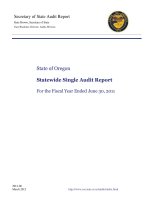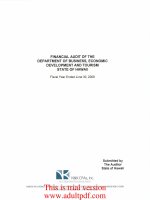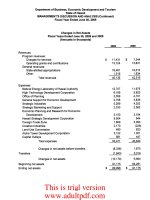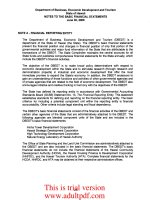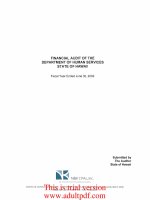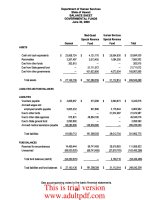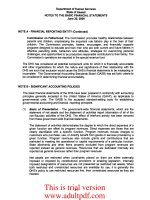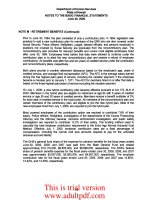Department of Transportation Statewide Audit – Selected Programs Fiscal Year Ended June 30, 1998 March 1999 Financial Audit Division Office of the Legislative Auditor State of Minnesota ppt
Bạn đang xem bản rút gọn của tài liệu. Xem và tải ngay bản đầy đủ của tài liệu tại đây (728.1 KB, 10 trang )
Department of Transportation
Statewide Audit – Selected Programs
Fiscal Year Ended June 30, 1998
March 1999
Financial Audit Division
Office of the Legislative Auditor
State of Minnesota
99-14
Centennial Office Building, Saint Paul, MN 55155 651/296-4708
SUMMARY
State of Minnesota
Office of the Legislative Auditor
1st Floor Centennial Building
658 Cedar Street • St. Paul, MN 55155
(651)296-1727 • FAX (651)296-4712
TDD Relay: 1-800-627-3529
email:
URL:
Department of Transportation
Selected Programs
Statewide Audit Fiscal Year 1998
Public Release Date: March 5, 1999 No. 99-14
Agency Background
The Department of Transportation (MnDOT) is responsible for providing a balanced
transportation system in Minnesota. The system includes aeronautics, highways, motor carriers,
ports, public transit, railroads, and pipelines. The department’s activities are funded primarily
from Trunk Highway Fund appropriations, federal grants, and bond proceeds. Department
expenditures for fiscal year 1998 totaled approximately $1.4 billion. Mr. James N. Denn was
the commissioner of the department during our audit scope. In January 1999, the Governor
appointed Mr. Elwyn Tinklenberg as the new commissioner.
Selected Audit Areas and Conclusions
Our audit scope was limited to those activities material to the State of Minnesota's general
purpose financial statements for the year ended June 30, 1998, and to the Single Audit
objectives. Our primary audit objective was to render an opinion on the State of Minnesota’s
financial statements. Our scope within the Department of Transportation included the Highway
Planning and Construction Program (CFDA 20.205), the Airport Improvement Program (CFDA
20.106), County State-Aid Highway Fund grants, Municipal State-Aid-Street Fund grants, and
bridge construction.
We qualified our report dated December 1, 1998, on the State of Minnesota’s general purpose
financial statements because insufficient audit evidence exists to support the State of
Minnesota’s disclosures with respect to the year 2000. Auditing the state’s year 2000
compliance efforts was not an objective of this audit. As a result, we do not provide assurance
that the Department of Transportation is or will be year 2000 ready, that its year 2000
remediation efforts will be successful in whole or in part, or that parties with which the
Department of Transportation does business will be year 2000 ready.
For the areas audited, the Department of Transportation’s financial activities were fairly
presented in the general purpose financial statements of the State of Minnesota’s Comprehensive
Annual Financial Report for the year ended June 30, 1998. We, along with the MnDOT Internal
Audit Section, noted the following reportable conditions involving internal control over
compliance related to the Highway Planning, Research, and Construction Program and the
Airport Improvement Program. The department did not complete supplemental agreements for
some construction projects prior to starting the additional work. The department did not properly
monitor compliance with the Davis-Bacon Act or with specifications for product material testing.
The Department of Transportation agrees with our report conclusions. The department is
working with the various divisions to resolve the audit issues.
Department of Transportation
Table of Contents
Page
Management Letter 1
Status of Prior Audit Issues 6
Department of Transportation Response 7
Audit Participation
The following members of the Office of the Legislative Auditor prepared this report:
Claudia Gudvangen, CPA Deputy Legislative Auditor
Renee Redmer, LPA Audit Manager
Carl Otto, CPA Auditor-in-Charge
Fubara Dapper, CPA Senior Auditor
Charlie Klein Auditor
Exit Conference
The findings and recommendations in this report were discussed with the following officials of the
Department of Transportation at an exit conference held on February 18, 1999:
Ed Cohoon Deputy Commissioner
Barbara Sundquist Director, Finance and Administration Division
Ronald Gipp Audit Director
Larry Kienitz Internal Audit Manager
Richard Swanson Director of Financial Management
Bonnie Kollmann Director of Financial Operations
Dennis Herzog Financial Reporting Supervisor
STATE OF MINNESOTA
OFFICE OF THE LEGISLATIVE AUDITOR
JAMES R. NOBLES, LEGISLATIVE AUDITOR
Representative Dan McElroy, Chair
Legislative Audit Commission
Members of the Legislative Audit Commission
Mr. Elwyn Tinklenberg, Commissioner
Department of Transportation
We have performed certain audit procedures at the Department of Transportation (MnDOT) as
part of our audit of the financial statements of the State of Minnesota as of and for the year ended
June 30, 1998. We also have audited certain federal financial assistance programs administered
by the MnDOT as part of our audit of the state’s compliance with the requirements described in
the U.S. Office of Management and Budget (OMB) Circular A-133 Compliance Supplement that
are applicable to each of its major federal programs for the year ended June 30, 1998. We
emphasize that this has not been a comprehensive audit of the Department of Transportation.
Table 1-1 identifies the financial activities within MnDOT that were material to the state’s
financial statements. We performed certain audit procedures on these MnDOT programs as part
of our objective to obtain reasonable assurance about whether the State of Minnesota’s financial
statements for the year ended June 30, 1998, were free of material misstatement.
Table 1-1
Expenditures Material to the State’s Financial Statements
Fiscal Year 1998
(in thousands)
Fund Area Amount
Trunk Highway Capital Outlay $430,674
County State-Aid Highway Grants to Counties $281,389
Municipal State-Aid Street Grants to Municipalities $108,813
Transportation Fund Bridge Construction Grants $10,195
Federal Fund Federal/County Road and
Bridge Grants
Airport Improvement Grants
$89,468
$17,622
Source: State of Minnesota Comprehensive Annual Financial Report and Minnesota Accounting and Procurement System (MAPS)
for fiscal year 1998.
MnDOT is responsible for the construction and maintenance of the state’s highway system.
Capital outlays are for highway construction, maintenance, and for right of way land purchases
1ST FLOOR SOUTH, CENTENNIAL BUILDING 658 CEDAR STREET ST. PAUL, MN 55155
TELEPHONE 651/296-4708 TDD RELAY 651/297-5353 FAX 651/296-4712 WEB SITE
Department of Transportation
2
on the state’s trunk highway system. The federal government provides various participation
percentages for approved projects related to highway construction, federal/county road and
bridge projects, and right of way acquisitions. Federally approved projects are eligible for
reimbursement under the Highway Planning and Construction Program (CFDA 20.205).
MnDOT is responsible for making state aid payments to counties and municipalities for road
construction and maintenance through the County State-Aid Highway and the Municipal State-
Aid Street Funds. The Departments of Revenue and Public Safety deposit fuel tax receipts and
motor vehicle registration tax receipts into the Highway User Tax Distribution Fund. Funds are
then transferred from Highway User Tax Distribution Fund to the Trunk Highway Fund, the
County State-Aid Highway Fund, and the Municipal State-Aid Street Fund, as well as to several
smaller state accounts. Distributions from the Highway User Tax Distribution Fund to MnDOT
are identified in Table 1-2.
Table 1-2
Highway User Tax Fund Distributions
Fiscal Year 1998
(in thousands)
Fund Amount
Trunk Highway $626,000
County State-Aid Highway $319,000
Municipal State-Aid Street $93,000
Source: State of Minnesota Comprehensive Annual Financial Report and Minnesota Accounting and Procurement System (MAPS)
for fiscal year 1998.
The MnDOT provides rail service improvement loans through the Minnesota Rail Service
Assistance Act of 1976. This program allows the state and rail users to enter into contracts with
railroads for rail line rehabilitation or other rail service improvements. Outstanding rail service
improvement loans as of June 30, 1998, totaled $18.5 million.
Table 1-3 identifies the State of Minnesota’s major federal programs administered by the
Department of Transportation. We performed certain audit procedures on these Department of
Transportation programs as part of our objective to obtain reasonable assurance about whether
the State of Minnesota complied with the types of compliance requirements that are applicable to
each of its major federal programs. We worked in conjunction with the MnDOT Internal Audit
Section to perform the Single Audit.
Department of Transportation
3
Table 1-3
Major Federal Programs Administered by the Department of Transportation
Fiscal Year 1998
(in thousands)
Program Name Federal State Total
Highway Planning and
Construction – CFDA 20.205 $300,355 $91,664 $392,019
Airport Improvement Program –
CFDA 20.106 $17,622 $1,260 $18,882
Source: Minnesota Accounting and Procurement System (MAPS) for fiscal year 1998.
We conducted our audit in accordance with generally accepted auditing standards and the
standards applicable to financial audits contained in Government Auditing Standards, issued by
the Comptroller General of the United States.
Conclusions
We qualified our report dated December 1, 1998, on the State of Minnesota’s Comprehensive
Annual Financial Report, because of uncertainties about the potentially adverse effect the year
2000 computer issue may have on state operations. Information technology experts believe that
many computer applications in private businesses and government may fail as a result of data
integrity problems and erroneous calculations beyond December 31, 1999. The state is currently
addressing year 2000 issues related to its computer systems and other electronic equipment.
During fiscal year 1996, the state established the Minnesota Year 2000 Project Office to develop
and monitor the overall statewide effort for executive branch agencies. The project office is
tracking over 1,300 mission-critical applications owned by state agencies. As of September
1998, the project office believed that 75 percent of the applications were compliant or had
completed the necessary modifications. However, because of the unprecedented nature of the
year 2000 issue, its effects and the success of related remediation efforts will not be fully
determinable until the year 2000 and thereafter.
Auditing the state’s year 2000 compliance efforts was not an objective of this audit. As a result,
we do not provide assurance that the Department of Transportation is or will be year 2000 ready,
that its year 2000 remediation efforts will be successful in whole or in part, or that parties with
which the Department of Transportation does business will be year 2000 ready.
In accordance with Government Auditing Standards, we have also issued our report, dated
December 1, 1998, on our consideration of the State of Minnesota’s internal control over
financial reporting and our tests of its compliance with certain provisions of laws, regulations,
contracts, and grants. At a later date, we will issue our report on compliance with requirements
applicable to each major federal program and internal control over compliance in accordance
with OMB Circular A-133.
Department of Transportation
4
For the areas audited, the Department of Transportation’s financial activities were fairly
presented in the general purpose financial statements of the State of Minnesota’s Comprehensive
Annual Financial Report for the year ended June 30, 1998. For the federal programs tested, the
department complied, in all material respects, with the types of compliance requirements
described in the U.S. Office of Management and Budget (OMB ) Circular A-133 Compliance
Supplement that are applicable to each of its major federal programs for the year ended June 30,
1998. However, as a result of the Federal Compliance Review performed by the MnDOT
Internal Audit Section, the following weakness in internal control and noncompliance with
program requirements were identified at the Department of Transportation.
1. The Department of Transportation did not comply with certain federal requirements
for the Highway Planning Construction Program and the Airport Improvement
Program
The Department of Transportation did not comply with certain regulations related to allowable
costs, materials testing, supplemental agreements, and the Davis Bacon Act. The MnDOT
Internal Audit Section issued a report to MnDOT management describing reportable conditions
involving internal control over compliance related to the Highway Planning and Construction
Program (CFDA 20.205) and the Airport Improvement Program (CFDA 20.106). The internal
audit report has six findings and two observations citing concerns related to allowable costs,
materials testing, supplemental agreements, and the Davis-Bacon wage requirements. These
findings and observations are listed below, with their corresponding recommendations.
• Paint blasting residue was not properly controlled. The Office of Environmental Services
developed a logbook monitoring system but it has not been implemented on all projects.
MnDOT Internal Audit Section recommended that a logbook system for all projects
involving paint blasting residue be implemented for the 1999 construction season.
• Concrete gradation requirements were not met on a bridge project. MnDOT Internal
Audit Section recommended that a policy be implemented to ensure bituminous and
concrete plant test results and decertification issues be communicated to project
engineers, including city/county engineers, in a timely manner. MnDOT should contact
the FHWA regarding plant decertifications and any impact on federal participation.
• Cost reimbursement plus fixed fee interim overhead rates were not adjusted to audited
overhead rates on Aeronautics contracts. MnDOT Internal Audit Section recommended
that the Office of Aeronautics communicate with applicable airport managers to ensure
that interim overhead rates are adjusted to the audited overhead rate.
• Controls are needed to improve closure of materials certification audits performed by the
Office of Materials and Road Research. MnDOT Internal Audit Section has five
recommendations to improve the materials certification process and follow up on
materials certification audit concerns.
• Approval of supplemental agreements needs to be completed prior to work being
performed. MnDOT Internal Audit Section recommended that supplemental agreement
work and payments follow established procedures. This is a prior audit finding.
Department of Transportation
5
• Controls need to be improved over compliance with the Davis-Bacon minimum wage
requirements. MnDOT Internal Audit Section recommended that MnDOT engineers
monitor and timely follow up on receipt of payroll documentation, inclusion of wage
classes, and labeling of payrolls with wage class codes. The MnDOT Internal Audit
Section also recommended the resolution of payroll concerns for certain state projects.
This is a prior audit finding.
In addition to the above findings, MnDOT Internal Audit Section had the following observations:
• Use of 3309 weathering steel appears more cost effective than using 3310 steel. MnDOT
Internal Audit Section recommended the development of a life cycle cost analysis
considering the cost and performance comparisons between 3309 and 3310 steel.
MnDOT should determine whether a revision to the policy regarding the painting of
bridge steel is needed.
• Timely incentive payments to contractors would reinforce contractor performance.
MnDOT Internal Audit Section recommended that incentive payments correlate with
material placement.
Recommendation
• The Department of Transportation should resolve these weaknesses in
internal control and noncompliance and implement the recommendations in a
timely manner.
This report is intended for the information of the Legislative Audit Commission and the
management of the Department of Transportation. This restriction is not intended to limit the
distribution of this report, which was released as a public document on March 5, 1999.
James R. Nobles Claudia J. Gudvangen
Legislative Auditor Deputy Legislative Auditor
End of Fieldwork: January 22, 1999
Report Signed On: February 26, 1999
Department of Transportation
6
Status of Prior Audit Issues
As of January 22, 1999
February 20, 1998, Legislative Audit Report 98-11 examined the MnDOT’s activities and
programs material to the State of Minnesota’s Annual Financial Report and the Single Audit for
the year ended June 30, 1997. The scope included selected state and federal programs as part of
the Statewide Financial and Federal Compliance Audit. The audit covered the Highway
Planning and Construction Program (CFDA 20.205), the Airport Improvement Program (CFDA
20.106), County State-Aid Highway Fund grants, Municipal State-Aid Street Fund grants, and
bridge construction. We found that the department's financial activities for programs included
in the audit scope were fairly presented in the State of Minnesota's Comprehensive Annual
Financial Report for fiscal year 1997. The department complied with the federal requirements
for the Highway Planning and Construction Program and the Airport Improvement Program.
This report included four reportable conditions involving internal control over compliance
related to the Highway Planning and Construction Program. The recommendation relating to
one of the findings was implemented. Three other issues were repeated as findings this year.
State of Minnesota Audit Follow-Up Process
The Department of Finance, on behalf of the Governor, maintains a quarterly process for following up on issues
cited in financial audit reports issued by the Legislative Auditor. The process consists of an exchange of written
correspondence that documents the status of audit findings. The follow-up process continues until Finance is
satisfied that the issues have been resolved. It covers entities headed by gubernatorial appointees, including most
state agencies, boards, commissions, and Minnesota state colleges and universities. It is not applied to audits of the
University of Minnesota, any quasi-state organizations, such as the metropolitan agencies or the State Agricultural
Society, the state constitutional officers, or the judicial branch.
